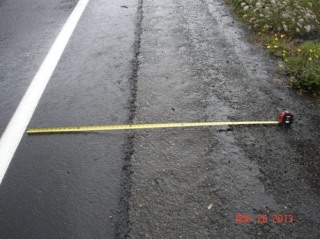
conditions on Monday.
(Photo: ODOT)
A regional manager with the Oregon Department of Transportation (ODOT) has responded to a paving issue that was brought to the agency’s attention last week because of its impact to bicycle safety. ODOT Region 2 Manager Sonny Chickering says he is already looking into taking corrective measures to repair the dangerous seam left behind from a paving overlay project on several miles of the Oregon Coast Bike Route. Chickering also forwarded a new page on the ODOT website that addresses this issue directly.
As we reported last Monday, Jeff Smith, a 30-year veteran of the Portland Bureau of Transportation, was riding the Oregon Coast Bike Route on Highway 101 south of Florence when he was “gobsmacked” at what he called an “inept” repaving job. He emailed ODOT (and cc’d dozens of his contacts) a photo and description of several miles of the highway where a new layer of pavement extended only half-way into the shoulder. The new layer of pavement left behind a rough ledge running right in the middle of the bicycling area.
A few days later, we shared that this method of re-paving runs afoul of ODOT’s own pavement design guide (and a bike-centric paving policy change that went into effect in August 2011). We also shared reports of similar paving practices on highways throughout the state.
Chickering promised a response by today, and he has delivered. In an email addressed to Smith, Oregon Coast bike advocate Ken Dennis, and myself, Chickering laid out his plans to address the issue.
“These repairs would likely involve repaving of the shoulders so that a smooth and uniform surface is available to non-motorized modes of travel.”
— Sonny Chickering, ODOT Region 2 Manager
“We have confirmed that the pavement surface along the shoulders is not uniform in appearance or texture,” Chickering wrote in the email. He then referenced the 2011 Pavement Design Guide and pointed out that the Highway 101 paving project in question, “Regrettably, was not completed in according with the standards contained in the new policy.”
In defense of this particular re-paving job, Chickering said it was done during the summer of 2011, which is “about the same time” the new pavement design guidelines went into effect. He also admitted that prior to April 2011, “when, based on considerations for bicycle safety, the policy was changed,” repaving only half-way into the shoulder was “considered acceptable as a cost saving measure by ODOT.”
As for next steps, Chickering reports that the ODOT Office of Maintenance is working to identify options for short-term repairs that can be implemented before an already scheduled repaving project is set to happen in 2015. “These repairs would likely involve repaving of the shoulders so that a smooth and uniform surface is available to non-motorized modes of travel.”
“If affordable,” Chickering says, the repair work could be completed before the end of this summer. We expect to hear another update from Chickering in the middle of next week.
In closing, Chickering directly addressed the disconnect many people have pointed out between these paving practices and ODOT’s very strong pledges to respect bicycling at the same level as driving. “As you pointed out, ODOT has made a concerted and very public commitment to providing a transportation system that accommodates and encourages the use of all transportation modes. Correction of the nonconforming work in this section of US 101 will be a significant step toward achieving that goal.”
We’ll keep you posted once we learn when the pavement repairs will take place.
UPDATE, 9:20 am on 8/29: In a follow-up email, I asked Chickering whether or not he planned to share his experience with other regional managers so that ODOT could take a state-wide look at this issue. Here’s his response:
“I have personally spoken to Region 3 Manager Frank Reading, who has responsibility for Hwy. 101 from the Lane County line to the California border, and I know that several of my peers have been copied on e-mail or contacted directly or indirectly by various internal and external stakeholders. I do intend to provide all the Region Managers an update on this issue at our next regularly scheduled leadership team meeting in September.”
I also asked him to clarify whether or not the Highway 101 paving in question was done before or after the new policy was put in place. Here’s his reply:
“The paving project in question occurred after the new paving policy was approved. We should not have performed the work in accordance with the prior policy, so the cost of correction will be borne by ODOT.”

